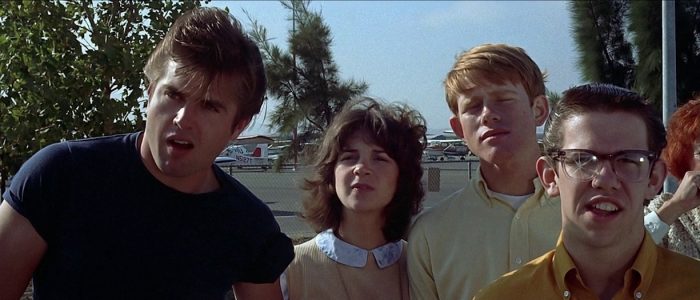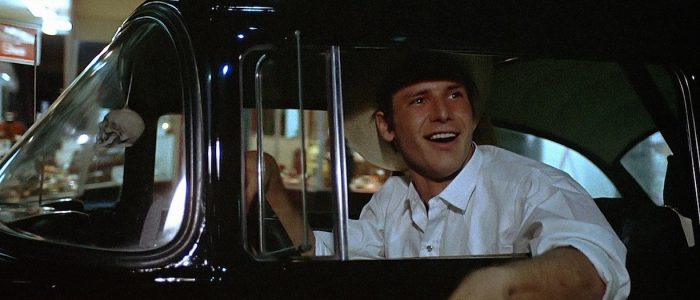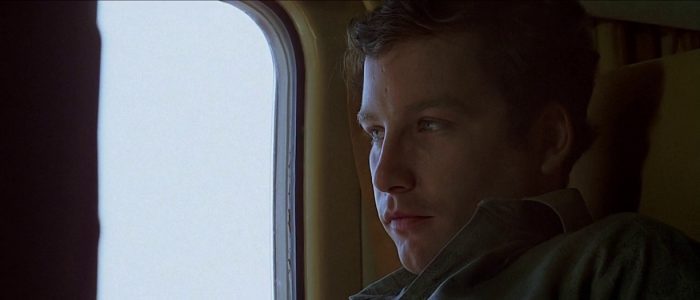'American Graffiti' At 45: Revisiting George Lucas' Pre-'Star Wars' Masterpiece
In 1971, a young director named George Lucas was coming off the commercial failure of his first feature-length motion picture, THX 1138. While that film has since gone on to achieve cult classic status as a pre-Star Wars curio, it was, at the time, a financial flop that earned mixed reviews. During the film's production, producer Francis Ford Coppola — who was on the cusp of his own mainstream directorial breakthrough with The Godfather — had issued a challenge to Lucas. The challenge was to write a screenplay with more mainstream appeal, something audiences would enjoy, a crowd-pleaser.
The result was American Graffiti. Released in August of 1973, American Graffiti remains the most down-to-earth, human movie Lucas ever made. There are no space battles here, just a group of kids cruising around town on the last night before two of them are supposed to go off to college. That relatable, coming-of-age aspect gives the film a timeless quality. Yet being four and a half decades removed from its debut in theaters and several generations removed from the time period it evokes also means that its setting might look as alien as a Star Wars planet to some viewers. The movie presents a vision of an America long gone, one where carhops roller-skate through the parking lot of drive-in restaurants and teenagers drag race through the streets in hot rods.
Let's take a look back at American Graffiti in honor of its 45th anniversary.

American Graffiti opens with the sun setting behind Mel's Drive-In in the town of Modesto, California, where Lucas grew up in real life. It's a fitting image in that the film will depict a time when the sun was setting on the Golden Age of Hollywood and the first phase of rock 'n' roll, and America was about to lose its residual sheen of '50s innocence with the JFK assassination and the further escalation of the Vietnam War. Against this backdrop, Lucas would also tell the story of two high school graduates and their friends experiencing a sunset of sorts on the carefree joy-riding days of their youth.
Lucas co-wrote the script for American Graffiti with Gloria Katz and Willard Hyuck and the fact that it utilizes 1962 slang makes it difficult to parse which lines of dialogue are really his and which are just a corny byproduct of the era in question. "We're finally getting out of this turkey town!" exhorts Ron Howard's character, Steve. "What a bitchin' babe," breathes Charles Martin Smith's character, Terry, AKA Toad.
Aside from a few eye-roll-inducing moments like these, however, the movie is basically perfect, a picaresque, verve-filled journey through one eventful night in the life of its teen protagonists. It's a testament to both Lucas' creative powers in the 1970s and to the influence of his collaborators and peers, fellow New Hollywood contemporaries like editor Marcia Lucas (then his wife), producer Gary Kurtz, and Coppola, who helped temper his technically adroit, yet socially awkward garage-movie approach and give it some more warmth and humanity — twin pillars of accessibility for the filmgoing public outside the garage.
Revisiting American Graffiti, seeking to celebrate it as it celebrates life, it's nonetheless difficult not to think of what came later: how Lucas showed promise as an up-and-coming auteur yet would come to signify a cautionary tale for creative people about the dangers of success. Maybe it's just that he lost touch with some of his own humanity as a storyteller as he got swallowed up by his toy empire and experimental green-screen playroom in later years. Suddenly the rogue filmmaker became an entrepreneur and CEO, surrounded by "yes" men. That's the counter-myth, anyway, to the officially sanctioned, revisionist myth of the genius with the long-held, multi-episode plan that Lucas himself helped promulgate throughout Star Wars history.
Before he became the architect of a grand space saga, Lucas was just a kid trying to make it in Hollywood. Improv, no doubt, played a part in the naturalistic feel of American Graffiti, as did the film's unpretentious, documentary-style cinematography. There is also the film's killer jukebox soundtrack, which paved the way for future time-capsule dramas like Forrest Gump. If music is life, then Lucas invokes a lot of life in this film with hits from artists like Chuck Berry and the Beach Boys. But unless some of the other above-mentioned factors fundamentally affected his artistic mojo, how else does one explain the striking disparity between the vibrant young people in American Graffiti versus the stiffs in the Star Wars prequels?

Three of the four friends that American Graffiti centers on were based on aspects of Lucas himself at different phases in his youth. These autobiographical shadings make the film ring true because Lucas is writing what he knows. He knows about being inept and geeky around girls: that's the version of him that we see as Toad. He knows about racing on the underground circuit in souped-up cars: that's the version of him that we see as Milner, played by Paul Le Mat.
The funny thing is, Milner contains the cowboy DNA of Han Solo, just as this movie's racing scenes contain the DNA of the Death Star trench run in A New Hope, the forest speeder bike chase in Return of the Jedi, and the canyon podrace in The Phantom Menace. Yet the real Han Solo, a young, Stetson-hat-wearing Harrison Ford, also shows up in American Graffiti as a drag-racing challenger to Milner. It's no coincidence that he loses their climactic sunrise race by flipping his car. Lucas had a similar experience growing up, one that would cause him to give up his early dream of being a race-car driver.
The other version of Lucas that we see is the character Curt, played by Richard Dreyfus. Curt embodies the wavering uncertainty of youth. He's supposed to board a plane to the Northeast the next morning, but in the meantime, he's the one wandering the empty halls of his high school nostalgically while everyone else dances at the sock hop. Though they eventually reverse roles, Curt is at first contrasted with Steve, who is more eager to go off and be the free-spirited college kid, so much so that he tries to convince his loving girlfriend Laurie (Cindy Williams) that they should be free to play the field and date other people while he is away.
Curt spends much of the movie chasing the dream of the elusive blonde in the white Thunderbird. "I just saw a vision," he enthuses. "I saw a goddess. ... This was the most perfect dazzling creature I've ever seen. She spoke to me. She spoke to me right through the window."
In a nutshell, she's his muse. Another is the DJ Wolfman Jack, whose voice inhabits the film like a phantom (not a menacing one). "The Wolfman is everywhere," we're told at one point. Curt eventually has a man-behind-the-curtain encounter with the Wolfman in his radio station. He feels the call of these muses, and while Steve and Laurie may be unimpressed, it's telling that Steve ends up staying in Modesto to go to junior college like Lucas himself did. Perhaps he's a version of Lucas, too, the one from an alternate reality where Lucas never got out of his hometown but instead settled into the domesticated life of an insurance salesman. Curt's the one who made it to USC film school: he flies off to university the next morning, but not before catching one last glimpse of the blonde in the T-bird on the ground below.

Bristling with humor and empathy, American Graffiti is another one of those contenders for the list of Best Picture nominees that should have won. It faces some stiff competition in that department from The Exorcist — another 1973 nominee — but at the very least, this a film that helped launch numerous careers, over and above that of Lucas.
After American Graffiti, Richard Dreyfus and Harrison Ford would make Jaws, Close Encounters of the Third Kind, and the Indiana Jones trilogy with Stephen Spielberg. Prior to this, Ron Howard was known mainly as a child actor from The Andy Griffith Show, but he, Cindy Williams, Mackenzie Phillips (Milner's 12-year-old tag-along) and Suzanne Somers (who cameoed as the radiant T-bird blonde) would go on to star in the hit sitcoms Happy Days, Laverne & Shirley, One Day at a Time, and Three's Company, respectively. Howard would also go on to become an Oscar-winning director, making Apollo 13 and A Beautiful Mind and working with Lucas again on Willow and this year's Solo: A Star Wars Story. For his part, Charles Martin Smith would star alongside Kevin Costner and Sean Connery as one of The Untouchables.
"You can't stay 17 forever," Steve tells Curt in the movie. "We're not kids anymore." Maybe that's true, but maybe more filmmakers should look to the example of American Graffiti and aspire to keep the spirit of youth alive in their careers.
Had Lucas really adhered to that ideal — had he stayed a true-blue Rebel — it's possible he would have divorced himself from the business concerns of Star Wars much earlier and let other filmmakers take turns leaving their own mark on the franchise, which is what he originally envisioned for it, anyway. Like Coppola, who always insisted that he wanted to make smaller-scale, personal movies, but who was arguably at his best when helming epic adaptations like The Godfather, The Godfather, Part II, and Apocalypse Now, Lucas wanted something for himself but life had other plans.
Many adults can probably relate to that. Tragic as it might be to see the squandered potential of some character's lives, that's what makes American Graffiti's written epilogue so essential. Some of us make it; others don't. In a way, this film, like the diverging arcs of Luke and Anakin Skywalker, could almost be read as Lucas' fictional autobiography. Maybe his own story belongs up there in the epilogue with the fates of the four friends. Maybe ours do, as well. Who knows what other earthbound human dramas we might have seen from the director of American Graffiti?
